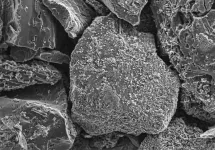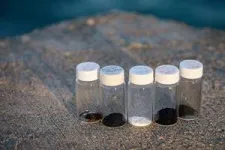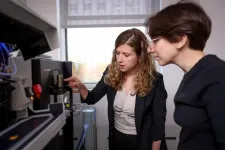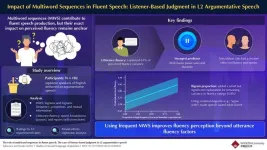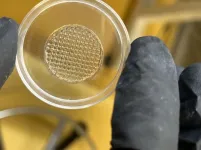(Press-News.org) ‘Vast majority’ of direct air capture research through air’s moisture swings relies on engineered ion exchange resins to sequester CO2
Other previously untested materials with dual functions like aluminum oxide and activated carbon would reduce associated energy and cost
Cheap, scalable carbon capture will be critical to reducing worldwide carbon footprint
EVANSTON, Ill. --- Researchers at Northwestern University have expanded the potential of carbon capture technology that plucks CO2 directly from the air by demonstrating that there are multiple suitable and abundant materials that can facilitate direct air capture.
In a paper to be published on Thursday (April 3) in the journal Environmental Science & Technology, the Northwestern researchers present new, lower-cost materials to facilitate moisture-swing to catch and then release CO2 depending on the local air’s moisture content, calling it “one of the most promising approaches for CO2 capture.”
Atmospheric CO2 continues to increase and, despite considerable worldwide efforts to cut down on carbon waste, is expected to rise more in coming decades. Exploring efficient and economical ideas for how to sequester excess CO2 from air can help make up ground by offsetting emissions from delocalized sectors like aviation and agriculture, where emissions are particularly difficult to pinpoint and capture.
Moisture-swing direct air capture (DAC), which uses changes in humidity to catch carbon, will be central to global strategies to combat climate change, but its scalability has been limited due to the previously ubiquitous use of engineered polymer materials called ion exchange resins. The team found they could reduce both cost and energy use by employing sustainable, abundant and inexpensive materials — often sourceable from organic waste or feedstock — to make DAC technologies cheaper and more scalable.
“The study introduces and compares novel platform nanomaterials for moisture-swing carbon capture, specifically carbonaceous materials like activated carbon, nanostructured graphite, carbon nanotubes and flake graphite, and metal oxide nanoparticles including iron, aluminum and manganese oxides,” said Northwestern materials science and engineering Ph.D. candidate John Hegarty, a co-author. “For the first time, we applied a structured experimental framework to identify the significant potential of different materials for CO2 capture. Of these materials, the aluminum oxide and activated carbon had the fastest kinetics, while the iron oxide and nanostructured graphite could capture the most CO2.”
The paper demonstrates the significance of a material’s pore size (pockets of space within porous materials where carbon dioxide can nestle) in predicting its power to capture carbon. The engineers argue this type of research will support the development of design principles to improve performance by modifying a material’s structure.
Scaling carbon capture
Traditional methods to directly capture atmospheric CO2 have failed to be competitive in many markets due to their high costs and technical complexity. More accessible and lower-cost DAC technologies could offset the emissions from agriculture, aviation, and concrete and steel manufacturing sectors that are challenging or impossible to decarbonize through renewable energy alone.
“The moisture-swing methodology allows for CO2 to be sequestered at low humidity and released at high humidity, reducing or eliminating the energy costs associated with heating a sorbent material so it can be reused,” said McCormick School of Engineering Ph.D. graduate Benjamin Shindel. According to Shindel and the study’s other authors, the modality is appealing because it enables carbon removal from virtually anywhere and can leverage synergies to connect to other systems that will operate in a carbon utilization paradigm.
“If you design your system correctly, you can rely on natural gradients, for example, through a day-night cycle or through leveraging two volumes of air of which one is humid, and one is already dry in geographies where that makes sense,” said materials engineering Professor Vinayak P. Dravid, who led the research.
Dravid is the Abraham Harris Professor of Materials Science and Engineering at McCormick and a faculty affiliate of the Paula M. Trienens Institute for Sustainability and Energy. He is also the founding director of the Northwestern University Atomic and Nanoscale Characterization (NUANCE) Center as well as the Soft and Hybrid Nanotechnology Experimental (SHyNE) Resource, and also serves as the associate director for global programs at the International Institute of Nanotechnology. Hegarty and Shindel share first authorship, and Weinberg College of Arts and Sciences Ph.D. student Michael L. Barsoum and his advisor, Northwestern chemistry chair and Professor Omar K. Farha, are also authors.
After the team assessed why ion exchange resins worked so well at facilitating capture — a combination of ideal pore size and the presence of negatively charged ion groups on their surfaces that carbon dioxide can attach to — they identified other platforms with more abundance and similar properties, with a focus on materials that would not put additional strain on the environment.
Previous literature tends to wrap together the mechanics of the entire system, making it difficult to assess the impact of individual components on performance. Hegarty said by looking systematically and specifically at each material, they found a “just right” middle range of pore size (around 50 to 150 Angstrom) with the highest swing capacity, finding a correlation between the amount of area within pores and the capacity the materials exhibited.
The team plans to increase their understanding of the new materials’ life cycles that includes both overall cost and energy use of the platform, and hopes it inspires other researchers to think outside the box.
“Carbon capture is still in its nascent stages as a field,” Shindel said. “The technology is only going to get cheaper and more efficient until it becomes a viable method for meeting emissions reductions goals for the globe. We’d like to see these materials tested at scale in pilot studies.”
The paper, “Platform materials for moisture-swing carbon capture,” was supported by the Department of Energy (DOE-BES DE-SC0022332), and all characterization and measurements were supported by the National Science Foundation’s National Nanotechnology Coordinated Infrastructure Midwest network node, called the SHyNE Resource.
END
Carbon capture could become practical with scalable, affordable materials
Researchers can pull carbon directly from the air using changes in humidity, now with materials at a fraction of the cost
2025-04-03
ELSE PRESS RELEASES FROM THIS DATE:
USC Norris Comprehensive Cancer Center opens state-of-the-art Newport Beach Radiation Oncology and Imaging Center
2025-04-03
Photos and b-roll package available for download here.
LOS ANGELES — USC Norris Comprehensive Cancer Center, part of Keck Medicine of USC, has opened Keck Medicine of USC – Newport Beach Radiation Oncology and Imaging, a state-of-the-art radiation oncology and imaging center, at 4590 MacArthur Blvd. in Newport Beach.
The 12,500 square-foot clinical space houses new-to-market imaging and radiation therapy technology in a serene, beach-inspired space designed to help patients feel at ease.
“Our new radiation oncology and imaging center demonstrates our ongoing commitment to providing Orange County with world-class care,” said Rod ...
Chan Zuckerberg Biohub New York announces new investigators for immune system research to improve human health
2025-04-03
New York City, New York (April 3, 2025) – The Chan Zuckerberg Biohub New York (CZ Biohub NY) today announced nine new investigators to its growing roster of talented researchers. Joining from Columbia University, The Rockefeller University, and Yale University, the eight projects will focus on the Biohub’s mission to harness and bioengineer immune cells for the early detection, prevention, and treatment of a broad spectrum of age-related diseases, including neurodegenerative disorders and aggressive cancers. The funded projects support a variety of innovative strategies, including leveraging synthetic biology to address the limitations of current ...
New research suggests White Americans in areas with higher Black poverty are more likely to blame racial inequality on lack of effort
2025-04-03
New research in Social Psychological and Personality Science shows that White Americans living in counties with higher Black poverty rates are more likely to believe racial equality of opportunity exists, while attributing racial disparities to lack of effort.
Led by Dr. Nicolas Sommet, the research included three studies with over 17,000 participants across hundreds of U.S. counties, using both observational and experimental methods to examine how exposure to racial inequality shapes beliefs about its causes.
"Our findings highlight how the environment we live in shapes how we understand racial inequality," explains ...
Solar wave squeezed Jupiter’s magnetic shield to unleash heat
2025-04-03
A massive wave of solar wind that squished Jupiter’s protective bubble has been detected for the first time.
Scientists at the University of Reading have discovered a solar wind event from 2017 that hit Jupiter and compressed its magnetosphere – a protective bubble created by a planet's magnetic field. This created a hot region spanning half Jupiter's circumference and exhibiting temperatures exceeding 500°C – significantly higher than the typical 350°C atmospheric background temperature.
A new study published today (Thursday, 3 April) in Geophysical Research Letters, describes for the first time a solar burst that scientists now believe hits ...
Cognitive decline comes sooner for people with heart failure
2025-04-03
There are over six million Americans with heart failure who are at greater risk of losing their cognitive abilities earlier in life, a study suggests.
The research team, led by Michigan Medicine, examined the cognitive abilities of nearly 30,000 adults over time, comparing those who did and did not develop heart failure.
The researchers found heart failure is associated with a significant decrease in cognition at the time of diagnosis.
Global cognition and executive functioning also declined more rapidly over the years after heart failure diagnosis, as people with the condition mentally aged the equivalent ...
SMEs’ ability to innovate is strongly tied to the learning and decision-making skills of managers
2025-04-03
The ways in which CEOs learn, apply what they have learned, and make decisions are significant to the innovating capabilities of SMEs, states Jutta Mäkipelkola in her doctoral dissertation at the University of Vaasa, Finland. Her research reveals how the skills of CEOs shape the capabilities of SMEs – and what kind of organisational culture drives innovation.
The importance of capabilities that enhance the innovativeness and renewal of companies has become more apparent during uncertain ...
Researchers recycle wind turbine blade materials to make improved plastics
2025-04-03
PULLMAN, Wash. – A new method to recycle wind turbine blades without using harsh chemicals resulted in the recovery of high-strength glass fibers and resins that allowed Washington State University researchers to re-purpose the materials to create stronger plastics.
The innovation provides a simple and environmentally friendly way to recycle wind turbine blades to create useful products.
Reporting in the journal, Resource, Conservation, and Recycling, the team of researchers cut the lightweight material that is commonly used in wind turbine blades, called glass fiber-reinforced polymer (GFRP), into approximately two ...
Low neighborhood walkability is associated with increased risk of cardiovascular disease
2025-04-03
Milan, Italy – 3 April 2025. Low neighbourhood walkability is associated with increased risk of cardiovascular disease (CVD), according to research presented today at ESC Preventive Cardiology 2025,1 a scientific congress of the European Society of Cardiology (ESC).
The health benefits of physical activity are well established and yet more than a quarter of adults do not meet the recommended guideline of 150 minutes of moderate-intensity physical activity per week.2 “Neighbourhoods designed ...
Common phrases, not fancy words, make you sound more fluent in a foreign language
2025-04-03
Language learners often assume that using rare, complex vocabulary will make their speech sound more fluent. Research suggests that there is a close relationship between formulaic expression usage in speech and acoustic features of oral fluency. This implies that using formulaic expressions leads to faster articulation speed and fewer disruptions during speech. However, in terms of how listeners perceive speakers’ fluency, the role of formulaic expressions has been unclear.
To investigate this, Ph.D. student, Kotaro Takizawa and Research Assistant Professor Shungo Suzuki from Waseda University, Japan, analyzed speech from 102 Japanese speakers ...
Printed skin to replace animal testing
2025-04-03
Directive 2010/63/EU laid down restrictions on animal testing for the testing of cosmetics and their ingredients throughout the EU. Therefore, there is an intense search for alternatives to test the absorption and toxicity of nanoparticles from cosmetics such as sun creams. A team of researchers from Graz University of Technology (TU Graz) and the Vellore Institute of Technology (VIT) in India is working on the development of skin imitations that mimic the native three-layer tissue structure and biomechanics of human skin. Such imitations can be produced ...
LAST 30 PRESS RELEASES:
University of Oklahoma researcher awarded funding to pursue AI-powered material design
Exploring how the visual system recovers following injury
Support for parents with infants at pediatric check-ups leads to better reading and math skills in elementary school
Kids’ behavioral health is a growing share of family health costs
Day & night: Cancer disrupts the brain’s natural rhythm
COVID-19 vaccination significantly reduces risk to pregnant women and baby
The role of vaccination in maternal and perinatal outcomes associated with COVID-19 in pregnancy
Mayo Clinic smartwatch system helps parents shorten and defuse children's severe tantrums early
Behavioral health spending spikes to 40% of all children’s health expenditures, nearly doubling in a decade
Digital cognitive behavioral treatment for generalized anxiety disorder
Expenditures for pediatric behavioral health care over time and estimated family financial burden
Air conditioning in nursing homes and mortality during extreme heat
The Alps to lose a record number of glaciers in the next decade
What makes a good proton conductor?
New science reporting guide published for journalists in Bulgaria
New international study reveals major survival gaps among children with cancer
New science reporting guide published for journalists in Turkey
Scientists develop a smarter mRNA therapy that knows which cells to target
Neuroanatomy-informed brain–machine hybrid intelligence for robust acoustic target detection
Eight SwRI hydrogen projects funded by ENERGYWERX
The Lundquist Institute and its start-up company Vitalex Biosciences Announces Strategic Advancement of Second-Generation fungal Vaccine VXV-01 through Phase 1 Trials under $40 Million Competitive Con
Fine particles in pollution are associated with early signs of autoimmune disease
Review article | Towards a Global Ground-Based Earth Observatory (GGBEO): Leveraging existing systems and networks
Penn and UMich create world’s smallest programmable, autonomous robots
Cleveland researchers launch first major study to address ‘hidden performance killer’ in athletes
To connect across politics, try saying what you oppose
Modulating key interaction prevents virus from entering cells
Project explores barriers to NHS career progression facing international medical graduates
Jeonbuk National University researchers explore the impact of different seasonings on the flavor perception of Doenjang soup
Two Keck Medicine of USC Hospitals named Leapfrog Top Teaching Hospitals
[Press-News.org] Carbon capture could become practical with scalable, affordable materialsResearchers can pull carbon directly from the air using changes in humidity, now with materials at a fraction of the cost
